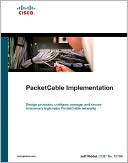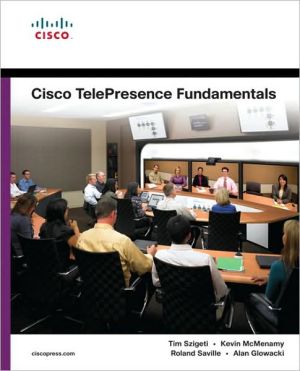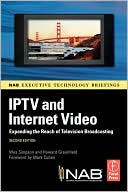PacketCable Implementation
Search in google:
PacketCable ImplementationDesign, provision, configure, manage, and secure tomorrow's high-value PacketCable networksJeff Riddel, CCIE® No. 12798PacketCable networks use IP technology to enable a wide range of multimedia services, from IP telephony to interactive gaming and beyond. Because PacketCable-based business and residential services are central to the cable industry's strategy for growth, the industry's need for PacketCable expertise is expected to increase dramatically.PacketCable Implementation is the first complete primer on PacketCable network design, provisioning, configuration, management, and security. Drawing on consulting experience with every leading cable operator, Jeff Riddel presents real-world case studies, sample network designs, configurations, and practical tips for all facets of PacketCable planning and deployment.This book's end-to-end coverage has been designed for cable engineers and networking professionals with widely diverse backgrounds and experience. Topics covered include PacketCable specifications and functional components, multimedia terminal adapters (MTA) provisioning, call signaling, media streaming, quality of service (QoS), event messaging, security, and much more. Every chapter contains tables and charts that serve as quick, easy references to key points. Each chapter closes with a summary and chapter review questions designed to help you assess and deepen your understanding.PacketCable Implementation brings together everything you need to know about cable networking to service delivery.Jeff Riddel, CCIE® No. 12798, is a network consulting engineer on the Cisco® Broadband Advanced Services team. There, he has consulted with all major U.S. MSOs, including Charter Communications, Comcast, AT&T, and Time Warner Cable. Riddel has represented Cisco in PacketCable interoperability testing at CableLabs in Louisville, Colorado. He holds a master's in electrical engineering from the Georgia Institute of Technology. Discover the PacketCable "big picture," including key application opportunities Learn about the latest generation of PacketCable standards and specifications, including PacketCable 2.0 and DOCSIS 3.0 Understand the functional components of a PacketCable network and how they fit together Walk step-by-step through provisioning, including protocols, flows, and MTA configuration Gain an in-depth understanding of call signaling: message formats, Network-based Call Signaling (NCS), PSTN interconnects, Call Management Server Signaling (CMSS), and more Implement efficient, high-performance media streaming Deploy, analyze, manage, and troubleshoot a state-of-the-art QoS framework Manage crucial network considerations, including lawful interceptIntroductionPart I Introduction and Overview of PacketCableChapter 1PacketCable OverviewChapter 2 PacketCable Functional ComponentsPart II MTA ProvisioningChapter 3 Provisioning OverviewChapter 4 Provisioning FlowsChapter 5 The MTA Configuration FilePart III Call SignalingChapter 6 Signaling Interfaces and MGCP OverviewChapter 7 NCS (Network-based Call Signaling)Chapter 8 TGCP and the PSTN InterconnectChapter 9 Call Management Server Signaling Protocol (CMSS)Part IV Media StreamChapter 10 Audio CODECsChapter 11 RTP and RTCPPart V Quality of ServiceChapter 12 DQoS Architecture and FrameworkChapter 13 Analyzing, Implementing, and Troubleshooting DQoSChapter 14 Multimedia ApplicationsPart VI Network ConsiderationsChapter 15 Event Messaging and Lawful InterceptChapter 16 PacketCable Network Design ConsiderationsPart VII AppendixesAppendix A Standards and SpecificationsAppendix B Cable Monitor and EtherealAppendix C Complete Call FlowsIndexThis book is part of the Networking Technology Series from Cisco Press®, which offers networking professionals valuable information for constructing efficient networks, understanding new technologies, and building successful careers.Category: Cisco Press–NetworkingCovers: Broadband Multimedia$75.00 USA / $94.00 CAN
IntroductionPart I Introduction and Overview of PacketCableChapter 1PacketCable OverviewPacketCable MotivationUnderstanding the PacketCable Big PictureStandardsIETF RFCsANSI/Telcordia, ITU, and Other SpecificationsDOCSIS SpecificationsPacketCable SpecificationsChapter SummaryChapter ReviewChapter 2 PacketCable Functional ComponentsMultimedia Terminal Adapter (MTA)Overview of the CM2P2BOverview of the CG2P2WBCable Modem (CM)Cable Modem Termination System (CMTS)Cisco CMTS ProductsCall AgentCall Management Server (CMS)Gate Controller (GC)Media Gateway Controller (MGC)Announcement Controller (ANC)Overview of the BTS 10200 SoftswitchSignaling Gateway (SG)Overview of the ITP Signaling GatewayMedia Gateway (MG)Overview of the MGX 8000 SeriesOverview of the AS5000 SeriesOSS/BSS BackOffice ComponentsOverview of BACRegional Distribution Unit (RDU)Revisiting the Cisco BTS 10200Record Keeping Server (RKS)Lawful InterceptChapter SummaryChapter ReviewPart II MTA ProvisioningChapter 3 Provisioning OverviewProvisioning OverviewProvisioning ProtocolsDHCPDNSTFTPHTTPTime-of-Day (ToD) ProtocolSystem Logging (syslog)SNMPKerberosCMTS ConfigurationBAC ConfigurationCNR ConfigurationRDU ConfigurationDPE ConfigurationKDC ConfigurationChapter SummaryChapter ReviewChapter 4 Provisioning FlowsDOCSIS Cable Modem ProvisioningScanning and Downstream SynchronizationObtaining Upstream ParametersRangingIP Connectivity EstablishmentTime of Day EstablishmentTransfer of Configuration InformationRegistrationBaseline Privacy InitializationPacketCable MTA ProvisioningThe Secure MethodThe Basic MethodThe Hybrid MethodMTA to CMS InitializationMTA to CMS Communication LossChapter SummaryChapter ReviewChapter 5 The MTA Configuration FileCisco Broadband ConfiguratorUsing the CBC GUIUsing the CBC CLIMTA Configuration File FormatDevice-Level Configuration DataDevice-Level Service DataPer-Endpoint Configuration DataPer-Realm Configuration DataPer-CMS Configuration DataNotification ReceiversBAC Configuration File CapabilitiesUsing TemplatesConfiguration File UtilityMTA Configuration After InitializationChapter SummaryChapter ReviewPart III Call SignalingChapter 6 Signaling Interfaces and MGCP OverviewDevice RelationshipEndpoints and ConnectionsMGCP Message FormatMGCP CommandsVerbsTransaction IDsEndpoint NameProtocol VersionMGCP ParametersMGCP Commands Not Directly Related to Call ControlPackages, Events, and SignalsMaking Calls and Call Control CommandsMGCP ResponsesResponse Codes and Reason CodesAdditional MGCP InformationSDP Protocol OverviewChapter SummaryChapter ReviewChapter 7 NCS (Network-based Call Signaling)NCS Variations from MGCPCommand Header FormatEndpoint Naming ConventionPackages, Events, and SignalsLocal Connection Option Parameters for CODECs and PacketizationLocal Connection Option Parameters for DQoSLocal Connection Option Parameters for SecuritySDP AttributesOther Notable ChangesExamining Call FlowsBasic ONNET CallFeature CallsConfiguring the BTS 10200Basic or Core Configuration TasksDial Plan Configuration TasksMTA Configuration TasksCall Feature Configuration TasksTroubleshooting TipsGeneral BTS Troubleshooting TipsTroubleshooting an MTA Not In ServiceDNS IssuesNo Dial Tone or Ring ToneNo Ring Back ToneNo Voice Path and One Way VoiceDQoS Not Established or DQoS Information MissingLarge Post Dial Delay IssuesParameter Negotiation ProblemsSDP ProblemsChapter SummaryChapter ReviewChapter 8 TGCP and the PSTN InterconnectPSTN Call Signaling OverviewSS7 OverviewLinks, Linksets, and RoutesThe MTP LayersThe SCCP and TCAP LayersThe ISUP LayerSignaling Gateway Overview and SigtranCAS OverviewTGCP OverviewTGCP Variations from MGCPCommand Header FormatTGCP Endpoint Naming ConventionPackages, Events, and SignalsLocal Connection Option Parameters for CODECs and PacketizationLocal Connection Option Parameters for SecurityLocal Connection Option Parameters for Lawful InterceptSDP AttributesOther Notable ChangesExamining Call FlowsBasic ONNET-to-OFFNET Call FlowBasic OFFNET-to-ONNET Call FlowEmergency 911 Call FlowCOT TestingComponent ConfigurationSignaling Gateway ConfigurationBTS 10200 ConfigurationSS7 and Signaling Gateway Configuration TasksTCAP Configuration TasksTrunking Media Gateway Configuration TasksDial Plan Configuration Tasks for OFFNET Call RoutingConfiguring a Trunking Media GatewayTroubleshooting TipsTroubleshooting the Cisco ITPTroubleshooting the Cisco BTS 10200Troubleshooting the Cisco VXSM and VISM Media GatewaysChapter SummaryChapter ReviewChapter 9 Call Management Server Signaling Protocol (CMSS)SIP OverviewCMSS/SIP in a PacketCable NetworkSIP RFCsSIP User Agents and SessionsSIP Proxy ServersSIP SecuritySIP Protocol FormatStart LineMessage HeaderMessage BodyExamining Call FlowsBasic CallError TracesCMSS Extensions of SIPDQoS ExtensionsPrivacy ExtensionsExtensions to Pass Additional InformationOther ExtensionsOther ModificationsCMSS TimersCMSS Call FlowConfiguring SIP and CMSS on the BTS 10200Step 1: Configuring the SIP/CMSS CharacteristicsStep 2: Configuring the SIP/CMSS Trunk GroupStep 3: Putting the Trunk Group into ServiceStep 4: Defining Routes for Trunk GroupsStep 5: Defining DestinationsStep 6: Defining the Dial PlanTroubleshooting TipsChapter SummaryChapter ReviewPart IV Media StreamChapter 10 Audio CODECsHow CODECs WorkPacketCable CODECsG.711G.728G.729EiLBCBV16Wideband CODECsCODEC NegotiationCODEC MetricsVoice ClarityDelayEchoVoice Path ProblemsNo Voice and One-way VoiceGarbled VoiceOther Voice ProblemsDTMF Digit TransportVoice Band Data (VBD) TransportAnalog Modem TransportFacsimile TransportTeletype Technology TransportChapter SummaryChapter ReviewChapter 11 RTP and RTCPRTP Protocol StackRTP Message FormatPayloads and Payload TypesSequence NumberTimestampSynchronization Source (SSRC)RTP Packet Trace AnalysisPacket Size ComparisonSilence Suppression (also Known as VAD)DTMF RelayFax Relay (T.38)RTCP OverviewRTCP Message FormatComponent Configuration and TroubleshootingThe Cisco CMS: BTS 10200The Cisco MG: VXSMThe Cisco MG: VISMMTA Configuration FileChapter SummaryChapter ReviewPart V Quality of ServiceChapter 12 DQoS Architecture and FrameworkDQoS OverviewGatesGate StatesCOPS ProtocolCOPS InitializationCMTS to CMS HeartbeatsPacketCable Objects in COPSDQoS TimersAuthorizing DQoS ResourcesSummary of RSVP Flow SpecificationsMapping SDP Information into RSVP Flow SpecificationsReserving and Committing DQoS ResourcesReviewing DOCSIS 1.1 QoSMapping DOCSIS Service Flows into RSVP Flow SpecificationsMapping DOCSIS Classifiers into Gate ClassifiersRevisiting CMTS AuthorizationChapter SummaryChapter ReviewChapter 13 Analyzing, Implementing, and Troubleshooting DQoSProtocol Message Flows and OperationBasic ONNET CallVAD and UGS-ADAdmission Control of Service FlowsMessaging in an Emergency 911 CallTying DOCSIS QoS to Backbone QoSConfiguration and Troubleshooting CommandsConfiguring PacketCable DQoS on a Cisco CMTSEnabling PacketCable Operation on the CMTSVerifying and Troubleshooting DQoS on a Cisco CMTSDebugging PacketCable DQoSTesting PacketCable DQoS FunctionalityBTS ConfigurationVerifying and Troubleshooting DQoS on the BTSTroubleshooting TipsCOPS Protocol IssuesUnexpected Gate Deletion from a Gate-Close MessageUnexpected Gate Deletion from a Gate-Delete MessageDOCSIS Protocol IssuesChapter SummaryChapter ReviewChapter 14 Multimedia ApplicationsPCMM OverviewPCMM ComponentsPacketCable Multimedia ClientsApplication Server (AS)Application Manager (AM)Policy Server (PS)Cable Modem Termination System (CMTS)Cable Modem (CM)RKSService and Resource Control DomainsPCMM DOCSIS Usage ConsiderationsPCMM COPS Usage ConsiderationsCOPS InitializationPEP to PDP HeartbeatsPacketCable Multimedia Objects in COPSPCMM Message Flow TemplatePCMM Message Flow ExampleEvent MessagingSecurityPCMM Configuration on a Cisco CMTSVerifying and Troubleshooting PCMM on a Cisco CMTSChapter SummaryChapter ReviewPart VI Network ConsiderationsChapter 15 Event Messaging and Lawful InterceptEvent Messaging Motivation and BackgroundEvent Message TypesEvent Messaging Call FlowEvent Messaging Configuration and TroubleshootingConfiguring Event Messaging on a BTS 10200Configuring and Troubleshooting Event Messaging on a Cisco CMTSPacketCable Lawful Intercept Motivation and BackgroundSurveillance TypesLawful Intercept TerminologyAF-DF CommunicationCommunicating Lawful Intercept Information to the CMTSCommunicating Lawful Intercept Information to the MGCommunicating Lawful Intercept Information Across CMSSDF-CF CommunicationCapturing Call Data and PCESPLawful Intercept Call FlowsCapturing Call ContentConfiguring Lawful InterceptTroubleshooting TipsChapter SummaryChapter ReviewChapter 16 PacketCable Network Design ConsiderationsSecurity ConsiderationsTypes of Security RequirementsUsage of the IP Security Architecture (IPsec)Configuring and Troubleshooting PacketCable SecurityQoS ConsiderationsCharacterizing Call Signaling TrafficQoS for NCS Packets on the DOCSIS NetworkBackbone QoS OverviewSetting DSCP CodepointsConfiguring Backbone QoS PoliciesUse of MPLS in BackboneCapacity Planning and Traffic EngineeringDetermining the Call Capacity of a DOCSIS UpstreamThe Effect of Changing Packetization IntervalThe Effect of Changing CODECThe Effect of Implementing PHSThe Effect of Implementing VADThe Effect of Implementing SecurityDifferences Among Cable LinecardsLine Usage and Traffic Pattern ConsiderationsCMTS Considerations Beyond the Upstream LimitationsCapacity Planning on the CMSCapacity Planning on the Trunking GatewayRedundancy, RedundancyCMS AvailabilityCMTS AvailabilityMTA AvailabilityMG AvailabilitySG AvailabilityOSS Server AvailabilityOther CMTS Design ConsiderationsLoad BalancingPacketCable FutureChapter SummaryChapter ReviewPart VII AppendixesAppendix A Standards and SpecificationsAppendix B Cable Monitor and EtherealAppendix C Complete Call FlowsIndex1587051818 TOC 1/16/2007







